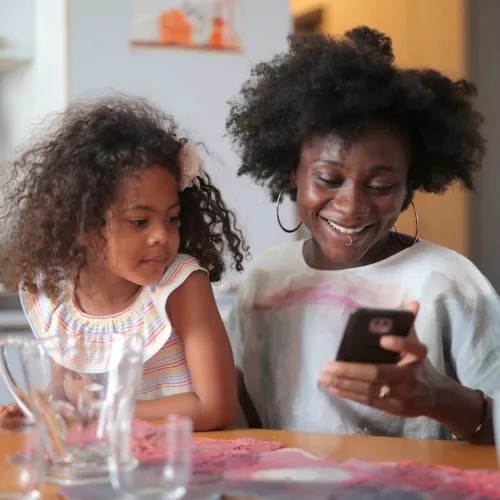Healthy Screen Time Guidelines for Families

Children are increasingly comfortable with the ubiquity of screens in our culture. Surrounded by people on cell phones, tablets, and laptops, children born in the past 10 years are growing up accustomed to a high level of digital device usage when at home, at school, or out and about.
Despite the likelihood of their own frequent digital device usage, parents may not be completely comfortable with their children’s instinct to turn to cell phones or tablets when bored.
Yet idly scrolling through the internet and social media has become so incredibly common that regulating screen time can be quite the challenge.
Meeting the challenge will require dedication, a certain level of strictness, and cooperation between households. Parents and children will also need a clear understanding of the motivations behind healthy screen time usage in order to stay on track.
Types of Screen Time
Not all screen time is created equal. We use electronics for a vast variety of purposes, so it’s natural that the pros and cons of screen time can vary depending on usage.
In a 2015 study focusing on the screen time usage of tweens and teens, Common Sense Media identified four broad categories to help parents better understand the patterns of their family’s screen time habits.
- Passive consumption: Watching videos or reading a book are two common examples of passive consumption. In their definition, 'passive' is not meant to be synonymous with 'disengaged.'
- Interactive consumption: Playing a video game or actively searching the internet are considered interactive digital consumption.
- Communication: Email, text messaging, and social media are inescapable methods of communication in modern society. Social media use comes with its own unique concerns and strategies.
- Content creation: Writing, composing music, drawing, coding, and other creative endeavours constitute their own unique form of screen time.
Parents can use these general categories when doing an inventory of their family’s screen time. For example, if a child is equal parts avid coder and Netflix binger, it’s helpful to recognize the difference between those screen time uses when deciding the best way to move forward.
Families must also recognize that different types of content have varying effects on their children. Media that focuses on communication and empathy, for example, is going to have a very different impact than one that highlights violence and conflict. Determining the best content for your children can be just as important as deciding time limits for digital media consumption. Use this checklist to help determine what content will be a positive influence and age-appropriate.
Reasons for Healthy Limits
With clear motivations, families will be more successful in changing their screen time habits. Here are three common reasons for parents to start searching for alternatives to digital entertainment.
Physical Health
One major benefit of reducing screen time is that it can free up a significant amount of time for physical activity.
The Centers for Disease Control and Prevention recommends that children and adolescents get at least 60 minutes of physical activity every single day. If your child is enrolled in a sport or other physical activity, meeting this requirement on practice or event days may be simple.
But if your child’s activities are not physically demanding, and your school district does not prioritize physical activity in their educational curriculum, getting to that one hour mark will require making some time for family exercise before or after school.
Problematic Media Use
Many of us are familiar with feeling the need to check our mobile devices multiple times per hour or the pressure to respond immediately to messages and social media posts. In a 2016 study entitled Technology Addiction: Concern, Controversy, and Finding Balance, 50 per cent of teens reported that they even felt ‘addicted’ to their mobile devices. This feeling of being unable to control media usage can be disorienting and stressful.
If media consumption gets to the point where it hinders participation in other meaningful activities, it can have a negative impact on a child’s long-term happiness and emotional well-being.
Building healthy screen time habits in children as they grow can give them the tools to be in control of their media usage later in life when digital device usage becomes a more prominent part of their daily activities.
Satisfying Sleep
Recent research has increasingly shown that exposure to light in the hours before bedtime can have a big effect on our ability to fall and stay asleep, especially for preschool-age children.
It’s not just the light from mobile devices that can have this effect. Even too bright of lights during story-time can suppress the production of melatonin, the hormone that naturally induces sleep.
For older children, it may not just be a screen’s effect on melatonin production that delays sleep. Scrolling through social media or watching TV at bedtime can also keep teenagers up way too late. Too little sleep can have a multitude of negative consequences for teens, including poor performance in school, an inability to concentrate, anxiety, and an increased likelihood of driving accidents due to drowsiness.
Plans for Healthy Screen Time Limits
In order to come up with a game plan for their family’s media usage, parents must first be willing to do a critical inventory of their own screen-time habits. As children learn behaviour and habits from their families, parents should be sure to stay on top of their own media consumption.
The 5-2-1-0 Rule
The 5-2-1-0 rule is a simple plan developed by the Canadian Childhood Obesity Foundation to help families stay active and healthy.
It recommends families adhere to the four following rules:
- Five or more servings of fruits and veggies
- Two hours or less of screen time,
- One hour of physical activity,
- Zero drinks with added sugar.
At the onset, parents may need to rely on a timer to prevent arguments about screen time limits. But because of its simplicity, this plan is easily implemented by families with children of all ages.
Sleep Hygiene
Sleep hygiene refers to all practices and behaviours that support regular and restful sleep patterns. Regulating screen time use before bedtime is just one facet of good sleep hygiene, which can also cover other behaviours such as daytime naps, caffeine ingestion, exercise, and diet.
With screen time, the key to sleep hygiene is minimizing digital device usage in the hour before going to bed. If screen time has become a part of your family’s bedtime routine, it may help to move forward with an ‘out of sight, out of mind’ mentality. That means no screens in children’s bedrooms and moving charging stations into the living room or kitchen.
Provide Alternatives
It can be difficult to overcome unhealthy screen time patterns when digital media is the default distraction for every idle moment. To counteract the instinct to turn to phones or tablets, parents should work to engage their children in other activities.
Extracurricular activities may be the obvious choice, but even something as simple as having small daily chores can keep children’s screen time at a healthy level. Parents can also regularly incorporate family-bonding time into their after-school and weekend schedules. Playing board games, taking nature walks, or baking a small treat are all easy and relatively inexpensive ways families can reduce digital media consumption together.
Changing your family’s screen time habits is a team effort. Co-parents need to be on the same page when implementing these changes, as inconsistency between households can delay success.
When families first begin to change their screen time strategy, tracking digital device usage can be vital for keeping them on track. Even before implementing any changes, co-parents may wish to start a shared log of their children's screen time habits to evaluate where potential problems lie. If on OurFamilyWizard, parents can take advantage of the journal feature to accomplish this.
Not on OurFamilyWizard? Try our full suite of tools risk-free for 30 days.



